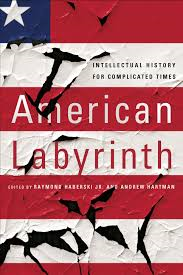The Book
American Labyrinth: Intellectual History For Complicated Times
The Author(s)
Edited by Raymond Haberski and Andrew Hartman
Editor's Note
This is the third installment of the American Labyrinth roundtable. Part one is here and part two can be found here.

The overall strength of the edited collection, American Labyrinth, comes in the fact that many of its essays seek to answer one of three questions. One: Who qualifies, in our historical scholarship, as an intellectual? Two: What constitutes intellectual history today? And, finally, three: Why do the previous two questions matter? American Labyrinth answers all three questions by showing how the field of intellectual history has grown incredibly diverse—in research methodology, topics researched, and practitioners within the field itself.
The volume itself is a meditation on how far the field of intellectual history has come since the famous 1977 Wingspread Conference. In a sense, however, many of the topics written about in American Labyrinth show how intellectual history as a field has long been in need of a reckoning—in terms of who is considered an intellectual and whose ideas we should carefully parse as being worth of further inquiry. Each essay, in its own way, is a rich work that deserves further study. But for the purposes of this essay I would like to focus on several.
Jonathan Holloway’s essay, “The Price of Recognition,” is a powerful entry within the collection precisely because he does not shy away from pointing out of how often American intellectual history has failed to grapple with so many important thinkers who should fall under its umbrella. The stakes of such erasure are, Holloway notes, not merely limited to the kinds of books and articles not being written within and outside of the academy. “’Black ideas,’ for want of a better term, regarding recognition—the lack of it and the moment of its emergence—turn, almost inevitably, toward literal and figurative violence.” (71) Needing to carefully consider whose ideas we put into conversation with one another is a critical aspect of modern intellectual history. How does a Black womanist intellectual, for one example, respond to the challenges laid out by someone thinking deeply about transgender identity? There is a mirror here—a reflection—of which voices we leave out in modern intellectual discourse reflecting the very same voices, as Holloway points out here, that are often ignored within the modern American university.
Something that struck me about Holloway’s essay was how perfectly Amy Kittlestrom’s essay before his—“Philosophy vs. Philosophers”—was a perfect entry point into Holloway’s thinking about intellectuals and privileged voices in the academy. For Kittlestrom, what is clear is that African American intellectuals who could have otherwise been excellent philosophers went into other areas of academic inquiry because of the urgencies of battles over Black freedom and social justice. Most African American thinkers have practiced something related to philosophical inquiry and discourse, even if it was not, itself, philosophy: “…unquestionably intellectual historians should be studying philosophical thinking wherever it has happened in the past, in the intellectual productions of all who have asked how things are and ought to be.” (65) Certainly, with the concurrent publishing of books such as New Perspectives on the Black Intellectual Tradition, we can acknowledge how historians are both pushing the boundaries of what is intellectual history, while also refreshing our understanding of the great debates, books, and essays of the past.
I think, therefore, it is critical to also highlight how the collection broadens thinking about intellectual history. I have highlighted the second section, “Ideas and American Identities,” not to leave behind the richness of the other sections, but because they demonstrate some of the new frontiers (for some, at least) of intellectual histories. I would never have considered fitness and the gender and class politics of the gym as part of intellectual history—at least, not until reading Natalia Mehlman Petrzela’s essay, “Thanks, Gender! An Intellectual History of the Gym.” Ruben Flores’ essay, “Parallel Empires,” follows up his earlier work about Civil Rights and transnational ideas of civil rights and education in the 1930s with a primer of why transnational history should never be a one-way street, as written about by historians based in the United States.
American Labyrinth, ultimately, is about refusing to see ideas as just a one-way discourse. The realm of ideas in the United States has always been “fractured” and full of “contradictions,” just to use two words associated with key titles in the field in recent years. But that’s where the excitement of the current field comes from—the excitement of understanding how so many thinkers and ideas intersect, clash, and compliment each other.
About the Reviewer
Robert Greene II is the Book Reviews Editor for the Society of U.S. Intellectual History.

0